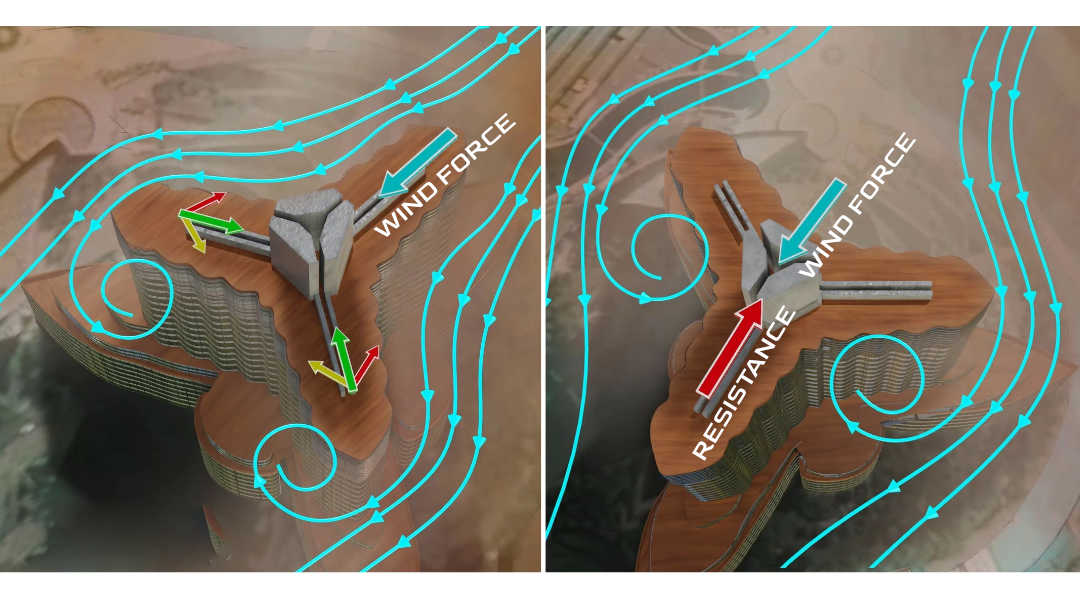
Counter Wind Frequency Risks
Discover how the Burj Khalifa overcomes wind-induced risks using advanced techniques. Learn about symmetry, uninformed shapes, aerodynamic designs, and the lessons skyscrapers have taken from history to ensure stability and safety.
When the Burj Khalifa opened in 2010, it wasn’t just the world’s tallest building but a monumental feat of engineering. Standing at 828 meters, the structure faced unique challenges, especially wind-induced vibrations that could compromise its stability. Such oscillations, if aligned with the building’s natural frequency, could lead to catastrophic failures. Engineers devised groundbreaking strategies, including symmetry, uninformed shapes, and aerodynamic designs, to counteract this danger. This article explores the innovative techniques behind the Burj Khalifa and lessons from historical structural collapses to understand why such measures are vital.
How Wind Interacts with Skyscrapers
The Science Behind Wind-Induced Oscillations
Wind doesn’t just flow past buildings; it interacts with their surfaces, creating vortices and pressures. These forces generate vibrations that, when matching the natural frequency of the structure, can lead to resonance. Resonance amplifies oscillations, causing severe swaying or, in extreme cases, structural failure. This phenomenon, known as wind-induced resonance, becomes increasingly critical in taller structures due to their flexibility.
Examples of Frequency Risks in Architecture
Structures resonate at specific frequencies based on their size, shape, and material composition. In tall buildings, the danger of wind resonance increases as height amplifies wind speeds. Without proper countermeasures, skyscrapers can sway dramatically, causing discomfort for occupants and potential damage to the structure.
Engineering Innovations in the Burj Khalifa
Symmetry and Uninformed Shapes in Design
The Burj Khalifa employs a highly symmetrical Y-shaped floor plan, which evenly distributes wind loads. Its staggered setbacks prevent wind vortices from forming in a consistent pattern, reducing resonance risks. This design ensures no single wind direction dominates, a critical factor in its stability.
The Role of Tuned Mass Dampers in Structural Stability
While the Burj Khalifa doesn’t use a traditional tuned mass damper (TMD), many skyscrapers incorporate these devices. TMDs are massive weights suspended within a structure, oscillating opposite to the building’s sway to neutralize motion. Although not a direct feature of the Burj Khalifa, its structural damping mechanisms achieve a similar effect, mitigating oscillations effectively.
The Burj Khalifa’s Aerodynamic Design
The tower’s tapering shape and setbacks create an aerodynamic profile that disrupts wind flow. This design minimizes the likelihood of vortices aligning with the building’s natural frequency. By “confusing” the wind, engineers significantly reduce the risk of resonance, ensuring the Burj Khalifa remains stable even under high wind conditions.
Lessons from History
Tacoma Narrows Bridge Collapse
In 1940, the Tacoma Narrows Bridge in Washington collapsed due to wind-induced resonance. Nicknamed “Galloping Gertie,” the bridge’s design failed to account for wind flow interactions, leading to its dramatic destruction.
John Hancock Tower: Glass Panel Failures
The John Hancock Tower in Boston faced severe wind-related challenges during construction. Resonant vibrations caused glass panels to pop out, posing safety risks. These failures highlighted the importance of testing structures against wind forces.
Citicorp Center Crisis: Lessons in Structural Safety
The Citicorp Center in New York narrowly avoided collapse due to design flaws exacerbated by wind conditions. Reinforcements and engineering corrections were required to stabilize the structure, underscoring the criticality of addressing wind forces in skyscraper design.
Global Impacts of Skyscraper Design
How the Burj Khalifa Sets Standards for Future Constructions
The Burj Khalifa’s engineering solutions serve as a model for future skyscrapers. Its blend of aesthetic and functional design demonstrates how modern architecture can address natural forces effectively.
Environmental and Urban Challenges of Building Tall Structures
While skyscrapers like the Burj Khalifa push the limits of engineering, they also raise environmental and urban challenges. Wind load considerations, energy efficiency, and urban integration are essential aspects future engineers must address to create sustainable cities.
The Burj Khalifa is more than an architectural marvel; it’s a testament to human ingenuity in overcoming natural challenges. By addressing wind-induced resonance through advanced design techniques, the tower stands as a symbol of innovation and resilience. As urban landscapes evolve, lessons from the Burj Khalifa and historical structures will continue to shape safe and sustainable skyscrapers for generations to come.
FAQs
What are wind frequency challenges in skyscrapers?
Wind frequency challenges arise when natural oscillations of a building align with wind-induced vibrations, causing resonance that can destabilize the structure.
How does symmetry help counter wind-induced issues?
Symmetry in skyscraper design distributes wind loads evenly, minimizing the risk of concentrated forces that could amplify oscillations.
What lessons have we learned from past building collapses?
Incidents like the Tacoma Narrows Bridge collapse emphasize the importance of accounting for wind forces in structural design to prevent resonance-related failures.
Why is the Burj Khalifa considered a marvel of engineering?
The Burj Khalifa incorporates innovative aerodynamic designs, symmetrical layouts, and advanced materials to counter wind forces, ensuring stability at unprecedented heights.
How does aerodynamic design improve skyscraper safety?
Aerodynamic designs disrupt wind flow patterns, preventing consistent vortices that could align with a building’s natural frequency and cause resonance.
What role do tuned mass dampers play in skyscraper stability?
Tuned mass dampers counteract building sway by oscillating in opposition to the structure’s motion, reducing discomfort and potential structural risks.
